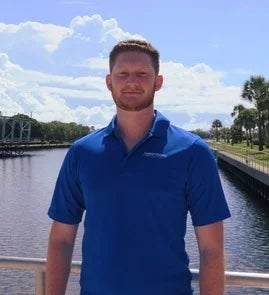Malachy McCaffrey will start his masters of science in oceanography this fall.
June 25, 2024
The University of Rhode Island Graduate School of Oceanography is proud to announce that incoming M.S. student Malachy McCaffrey is one of two students and four recent graduates to have been awarded a prestigious National Science Foundation Graduate Research Fellowship for 2024.
The NSF’s Graduate Research Fellowship Program recognizes and supports outstanding students in science, technology, engineering, and mathematics disciplines pursuing research-based advanced degrees in the United States. Fellows receive a substantial annual stipend, and funding for tuition and fees, worth $159,000 each over three years.
The National Science Foundation instituted the Graduate Research Fellowship in 1952, with the goal of encouraging scientific research and ensuring comprehensive research programs for students in the U.S. Since then, the NSF has funded more than 46,500 fellowships and many former graduate fellows have gone on to become Nobel laureates and members of the National Academy of Sciences.
Forward Motion
Malachy McCaffrey, a 2020 URI marine biology graduate from the Bronx, New York, is now studying for his master’s degree at URI’s Graduate School of Oceanography.
“URI’s proximity to the ocean and excellent research diving program were major factors that contributed to my decision to attend college here,” he says.
McCaffrey will complete his studies under the supervision of assistant professor Kris Lewis. He is interested in comparing long-term data from the GSO Narragansett Bay Fish Trawl Survey with water quality and nutrient monitoring data from the Narragansett Bay National Estuarine Research Reserve. He hopes to integrate these data sources with community-based data from local fishers to investigate how changes in water quality over space and time have affected fished species in Narragansett Bay.
Persistence was the key to McCaffrey’s success, receiving the fellowship after three attempts over four years. He wrote his first application in fall 2020 between hauls on fishing vessels out of Dutch Harbor, Alaska while working as a fisheries observer. He used what he learned from prior efforts to write a successful application the third time around.
McCaffrey says his time spent working in Alaska and as a water quality manager along the Texas Coastal Bend have informed his plans to study the ecological and human dimensions of marine resource use.
“By blending methodologies in the biological and social sciences, there is potential to make considerable advancements in our understanding of fisheries management and climate adaptation,” he says. “The goal of this research is to generate tangible, lasting benefits toward coastal ecosystems and the people that rely upon them.”
To learn more about the other fellowship awardees, read the full story in Rhody Today.
For more information about the NSF Graduate Research Fellowship Program, or other fellowship opportunities, visit www.nsfgrfp.org or contact Kathleen Maher (kmaher@uri.edu).

